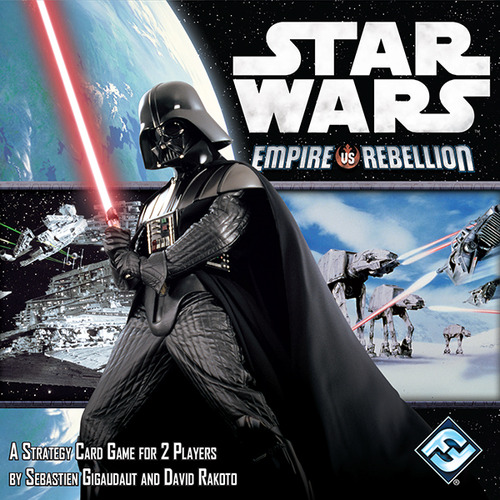Rustle up some cattle in Longhorn
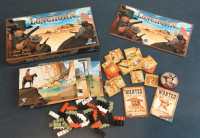
It’s time to do some cattle rustling in the Old West!
So round up another outlaw and see which of you can steal the most valuable cattle and the most gold nuggets in Longhorn.
The Wild West is a pretty popular theme for all kinds of entertainment. There’s a wide range of movies and TV shows about the rough life out on the range.
But that’s not the only form of Wild West entertainment. Board game and card games get in on the action as well. And the latest one we’ve played from Blue Orange Games is a fun one – Longhorn!
Longhorn is a 2-player board game that’s simple to learn, quick to play, and has fun, tactical decisions throughout.
How to play Longhorn
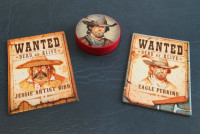
In Longhorn, players go head-to-head to snag cattle for their own herds and amass the most money by the end of the game.
To begin, players decide which outlaw they’ll be (Eagle Perkins or Jessie Artist Bird) and take their Wanted token. The 9 location tiles are then randomly placed to form a 3×3 grid.
Next, 9 Action tokens are randomly chosen and randomly placed on the location tiles. Lastly the 36 wooden cows are randomly placed on the location tiles – each tile receiving the indicated amount for that location.
Then the Outlaw token is flipped to see who goes first. The player who goes second gets to place the Outlaw token on one of the location tiles containing 4 cows (their choice).
Thus, if Eagle Perkins goes first, Jessie Artist Bird gets to place the Outlaw token on a tile with 4 cows. The Outlaw token will show Eagle’s image to indicate that it’s his turn.
On a player’s turn, the outlaw does 2 things: Steals cattle & Moves
Stealing Cattle
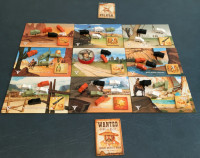
In the location where the Outlaw token is, he takes all the cattle of one color. These are added to his herd on the table in front of him.
If that location tile no longer has any cattle, then he must apply the affects of the Action token on that location. (Actions listed below.)
Moving Outlaw Token
After stealing cattle, that player moves the Outlaw token a number of spaces equal to the number of cows he stole. For example, if he took 2 white cows, he’ll move the Outlaw token 2 spaces (orthogonally) and flip the Outlaw token to the other side.
There are three things to keep in mind when moving. First, there is no return travel between two locations. Second, you cannot have the same player play twice in succession at the same dangerous location if other possibilities exist (dangerous = Sheriff or Rattlesnake). And third, if all locations situated at a distance determined by the number of stolen cows are empty, the game ends and points are totaled.
But before we get to scoring, let’s look at the special action tokens.
Action Tokens

There are 7 different type of Action tokens in Longhorn (and how many of each type in parenthesis).
- Sheriff (1) – If you have to take this token, the Sheriff caught you and you lose the game.
- Rattlesnake (2) – The outlaw who claims the rattlesnake loses cows. He must place one cow from each color in his herd back on orthogonally adjacent locations (distributed how he chooses).
- Ambush (3) – The outlaw who claims this token gets to steal either a gold nugget (taken at random) or two cows of the same color from his opponent.
- Branding Iron (3) – The outlaw who claims this token gets to steal all the cattle of the same color on one of the orthogonally adjacent tiles.
- Snake Oil (3) – The outlaw who claims this token gets to go again. They move the Outlaw token just like normal, but don’t flip it over. He goes again from there.
- Epidemic (1) – The outlaw who claims this token chooses a color and removes every cow of that color from the board (they all died and that color will be worthless at the end of the game).
- Gold Nuggets (6) – These tokens are worth their face value ($200, $300, $400, or $500) at the end of the game.
End of Game
The game can end in 1 of 3 ways:
- The Sheriff token is activated – that player loses the game.
- If an outlaw gets all 9 cows of one color – that player automatically wins the game.
- After stealing cows, the only locations the player can move to don’t have any cattle.
Scoring
If the game ended in the third manner above (which is the most common way for the game to end), players total their score. Their score is the combined value of any gold nuggets they’ve claimed plus the value of the cows in their herd.
Each cow in a player’s herd is worth $100 for each cow of the same color still on the board.
For example, if there are still 3 green cows on the board (not stolen) then every green cow in each player’s herd is worth $300.
Thus, if all cows of one color have been stolen, then each cow of that color will be worth $0 at the end of the game.
The player with the most money wins the game.
The game is really that simple – steal cattle and move that many spaces away.
Who would have thought a game that simple could be so fun?
What we like about Longhorn

First off, we’ll mention that the components in Longhorn are great. Just because it’s a small game, doesn’t mean Blue Orange Games has scrimped on the components. The location tiles are nice and thick. The tokens are thick as well. And the wooden cattle are a lot of fun to play with.
But the components aren’t what we like best about Longhorn.
What we like best is that it’s a fun head-to-head, quick 2-player battle that’s different every time we play.
The first thing we like is the randomized set up. While the rules never change, the way players need to navigate the game to win requires fresh thinking every time. And that’s because of the random set up.
First of all is the randomized layout of the location tiles. Each tile will receive a set amount of cattle to start the game, but the places of those tiles will shift every game.

The second thing randomized is the tokens. While all 9 boards are utilized every game, only 9 of the 19 tokens will be in play each game. And they’re also randomly placed in different locations every time. Some games may have a Sheriff. Some may not. Some games may have more gold nuggets and some more hazards. Thus, every layout will require some different strategies.
The third, and most obvious, randomized element is the distribution of the cattle themselves. The location boards indicate how many cattle they start with – but which color cattle get placed there is up to chance.
Once all these elements are randomly put in place, the maneuvering begins.
It makes for quite the puzzle to figure out how to move around to make the most of your turns and make your opponent get you where you want.
And I like puzzles.
I especially like head-to-head puzzling.
The unique scoring is another part of the game we enjoy. It’s always great to get a lot of cattle to score a lot of points. But the catch is that the value of each cow is determined by how many are still left on the board at the end of the game.
So if you steal a lot of a certain color, leaving only 1 of that color on the board, then each will only be worth $100. But if you just take a few and leave 5 of that color on the board, then each that you stole will be worth $500. It’s another level of thinking when figuring out which cows to take, which to leave, where to move, and when to force the game to end.
Very cool.
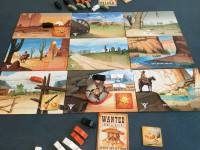
For example – in the situation pictured to the right, should Eagle end the game now by taking the last 2 white cows? It would mean that all white cows are worthless – hurting Jessie’s herd value. But if he takes the black cow, there is only one spot he can move to – which in turn Jessie will take either green or orange, thus making those worthless in the end. Plus it would send the token back to Nugget Hill in which Eagle will have to take the white cows, emptying the location tile and activating the Sheriff token and lose. So does he really have a choice? Take the white cows and end it.
Another element we like a lot about Longhorn is how quick it plays. It’s easy to play multiple games in a row because it’s so quick to set up and go again.
The most popular 2-player board game in the world is Chess. Sure it’s a great game to challenge the skill of your opponent. But all the pieces start in the same place every time and games can also take long to play.
Don’t get me wrong. I love a good game of Chess. But I also like to have 2-player games that can deliver some mental exercises in a short amount of time. And Longhorn strikes gold on that account.
How does Longhorn score on our “Let’s Play Again” game meter?
 If you just skipped that last little part, we’ll say it again. One of the things we love most about Longhorn is that it’s great to play multiple times in a row.
If you just skipped that last little part, we’ll say it again. One of the things we love most about Longhorn is that it’s great to play multiple times in a row.
With such simple rules, a game of Longhorn can go by relatively quickly. Even with players who are prone to analyze every move will find that they can’t plan too many turns ahead. So games will go by quickly even playing with those type of players.
Longhorn has found an easy to reach spot on our game shelves because we foresee it being played a lot.
Thanks Blue Orange Games for a fun and light 2-player, family board game!
Other Western-themed board games you might enjoy:

